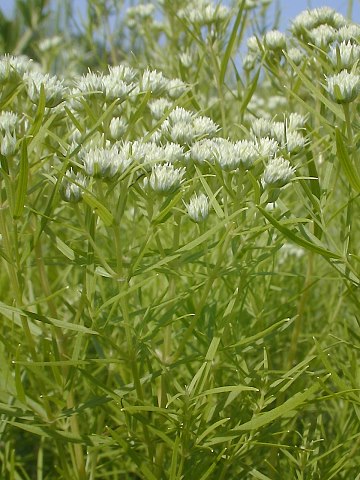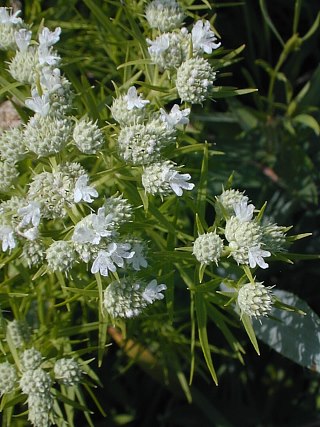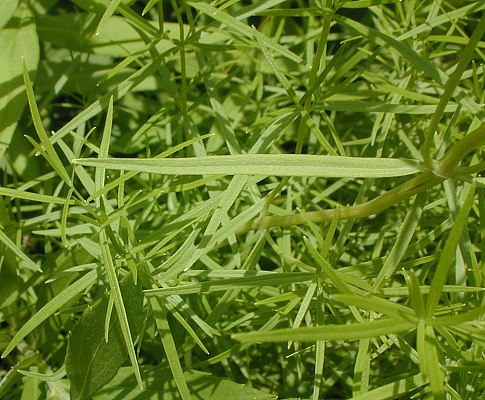Description: This perennial herbaceous plant is 1-3' tall, branching frequently to create a bushy effect. The slender stems are hairless. The slender opposite leaves are up to 3" long and ¼" across. Each leaf is sessile, linear, and hairless, with a prominent central vein and smooth margins.

The upper stems
terminate in small flat heads of flowers. The short tubular flowers are
white, often with scattered purple dots, and individually about ¼"
long. The corolla is divided into an upper lip and a lower lip with
three lobes. The reproductive structures of each flower are white,
except that the anthers are purple. The calyx is divided into several
slender green lobes. The blooming period is early to mid-summer, and
lasts about 1–1½ months. There is no floral scent, although the foliage
has a mild mint scent and somewhat stronger minty taste. The small dark
seeds are without tufts of hairs, but are small enough to be dispersed
by gusts of wind. The root system consists of a taproot and rhizomes.
Slender Mountain Mint can spread vegetatively, forming colonies of
closely bunched plants.
Cultivation:
The preference is full sun and moist to slightly dry conditions. This
plant often grows in rich loam, as well as soil containing rocky or
gravelly material. Foliar disease is less troublesome for this mint
species than many others. The leaves may assume a yellowish appearance
during a major drought. This is an easy plant to grow.

Range & Habitat:
The native Slender Mountain Mint occurs occasionally in every county of
southern
and central Illinois, but is less common and more sporadic in northern
Illinois (see Distribution
Map). Habitats include moist to slightly dry black soil
prairies, moist meadows and gravelly areas along rivers, openings in
woodlands, moist thickets, acid gravel seeps, limestone glades, and
abandoned fields.
Faunal Associations:
The flowers are very attractive to many kinds of insects, including
long-tongued bees, short-tongued bees, wasps, flies, butterflies,
skippers, beetles, and plant bugs. These insects usually seek nectar.
Among the wasps, are such visitors as Thread-Waisted wasps, Bee Wolves (Philanthus
spp.), Scoliid wasps, Tiphiid wasps, Sand wasps, Spider
wasps, and Eumenine wasps. Flies visitors include Soldier flies,
Syrphid flies, Mydas flies, bee flies, Thick-Headed flies, and Tachinid
flies. The seeds are too small to be of much interest to birds.
Mammalian herbivores usually don't browse on this plant because of the
minty taste; the foliage may contain anti-bacterial substances that
disrupt the digestive process of herbivores.
Photographic Location:
The photographs were taken at Meadowbrook Park in Urbana, Illinois.

Comments: This plant has a delicate, somewhat airy appearance. Slender Mountain Mint closely resembles Pycnanthemum virginianum (Common Mountain Mint), except that the former has hairless stems and leaves that never exceed ¼" across. Common Mountain Mint, on the other hand, has lines of white hairs on its stems, and some of the larger leaves will exceed ¼" across. This latter plant tends to be taller, stouter, and less branched in appearance; it also blooms a little later in the year. The photographed flowering plant is still in the bud stage, while the photographed flowerheads are beginning to bloom.